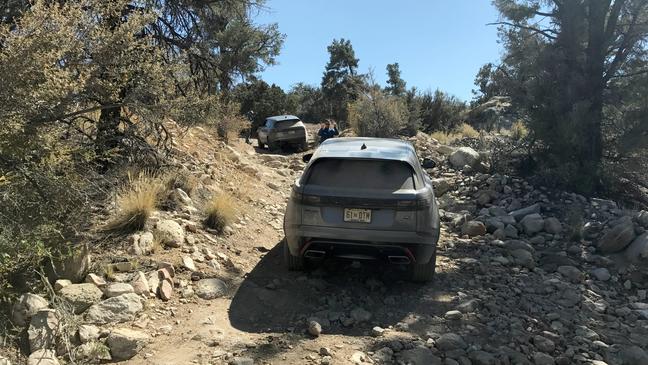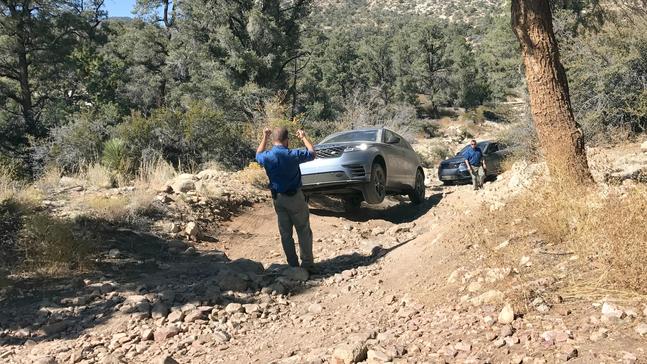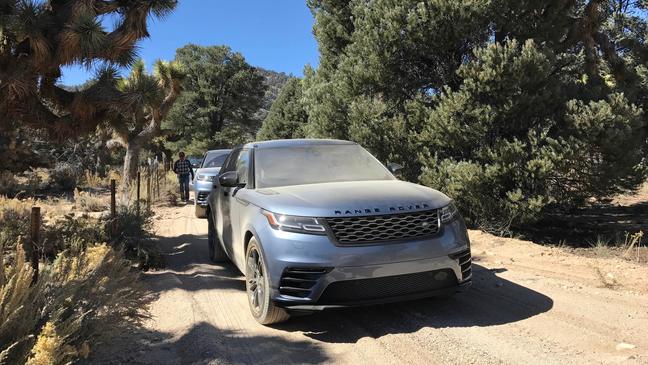2018 Land Rover Range Rover Velar: More than just a pretty face [First Look]
TOPICS:
Land Rover Range Rover VelarPALM SPRINGS, Calif. — Land Rover has the reputation of being a rough-and-tumble automaker with vehicles that can take you anywhere. In recent years, it has also become a symbol of luxury.
Not that many Land Rover owners will find themselves in the middle of a rock crawl. But they could if they wanted to.
During our day-long drive with the all-new 2018 Range Rover Velar, we did, in fact, find ourselves in the middle of a rock crawl. And while the chassis didn’t twist and bend to keep all four tires on the ground at all times, the mid-sized Velar did quite well.
That says a lot for a vehicle whose top-tier trim starts at about $90K.
We spent the majority of our time driving on highways and twisty mountain roads, which, frankly, is where most owners will take their Velar anyway.
We were mostly driving well-equipped versions of the Velar with the 380-horsepower V-6 engine. Our vehicle had features such as electronic air suspension, four-zone climate control, the off-road package and massaging front seats. So, the as-tested price of our primary test Velar was around $85K.
And we took it through dusty dirt trails filled with brambles and sharp rocks, past a line of Jeeps, the drivers of which thought we were all nuts (and said so as they passed).
But we weren’t nuts at all, and the Velar took everything we threw at it in stride.
This newest off-road-capable SUV from Land Rover will be available with three different engine options: two turbocharged 4-cylinders -- one gas and one diesel -- and a supercharged V-6.
The 3.0-liter V-6 is incredibly smooth and has everything you want in the power department with 380 horsepower and 332 pound-feet of torque. It accelerates quickly and effortlessly, which makes highway merges easy. The tradeoff is going to be fuel economy, as Land Rover estimates vehicles equipped with this engine will get 24 mpg on the highway and 19 mpg in the city.
If fuel economy is a sticking point, the turbocharged 2.0-liter, 4-cylinder gasoline engine is a nice option. Land Rover estimates 27 mpg on the highway and 21 mpg in the city. It delivers 246 horsepower and 269 pound-feet of torque, which isn’t quite as effortless as the V-6. But it’s still really decent.
Die-hard diesel fans will appreciate the 2.0-liter, 4-cylinder turbo diesel. Though the horsepower rating is low at 180, the 317 pound-feet of low-end torque and fuel economy make it attractive for those who tow or do a lot of highway driving. Land Rover estimates 30 mpg on the highway and 26 mpg in the city.
Of the three engines, the 4-cylinder gasoline version has the best of all worlds with quiet acceleration and good fuel economy. While I liked the performance of the diesel, it wasn’t as smooth or quiet as I hoped it would be.
The big story with the Velar, however, isn’t necessarily how it drives. It’s the technology. This new SUV introduces a lot of cool features I think (hope!) we’ll see trickle through the rest of the Land Rover lineup soon.
My favorite tech feature has to be the sleek and svelte Touch-Pro Duo. This dueling touch-screen system is beautifully done with expansive 10-inch screens and stunning four-color graphics. The top screen will manage things such as navigation, phone functions and audio, while the bottom screen handles vehicle settings and climate controls.
I’ve seen other automakers try to implement a dual screen on the center stack, and it’s never worked. Never. But Land Rover finally has the winning design. It makes the Velar look like a car of tomorrow rather than an old computer pieced together with spare parts.
The only complaint might come from the OCD folks among us: You will leave stubborn fingerprints on the sleek black screens.
Other notable tech features include 360-degree cameras, an air suspension system that is standard on the V-6 models, pop-out exterior door handles, magic dials that change functionality depending on the touch screen controls, a Wi-Fi hotspot for up to 8 devices and a premium Meridian 3D surround sound system.
That doesn’t even touch on the safety equipment that is available in the Velar, which includes automatic emergency braking, lane keep assist, adaptive cruise control, rear cross-traffic alert and blind spot monitoring.
Velar falls under the Range Rover branch of the Land Rover family, which embodies refinement. Also under this umbrella you have the Evoque, Range Rover Sport and Range Rover. Velar is slotted between the Evoque and Sport, with price overlap on both of those models.
The Velar trims include:
- Velar: Only available with the 4-cylinder gasoline engine. Base price $49,990.
- Velar S: Available in all powertrains. Base prices are $54,700 (4-cyl, gas), $56,200 (4-cyl, diesel) and $64,200 (V-6).
- Velar SE: Only available with the V-6 engine. Base price is $67,400.
- Velar R-Dynamic SE: Available in all powertrains. Base prices are $60,100 (4-cyl, gas), $61,600 (4-cyl, diesel) and $69,600 (V-6).
- Velar R-Dynamic HSE: Available in all powertrains. Base prices are $67,600 (4-cyl, gas), $69,100 (4-cyl, diesel) and $77,100 (V-6).
- Velar First Edition: Only available with the V-6 engine. Base price is $89,300.
While we were able to spend time with each engine, we weren’t able to see any of the base trims. So, it’s hard to speak about interior quality as you head toward the base price.
We were, however, able to check out the new Kvadrat cloth interior, which is a premium option for those who can’t condone or don’t want leather. I actually liked these seats better than the leather – they felt more comfortable. And you don’t miss out on any of the massaging, heating, cooling options just because you opt out of leather – which is really nice.
Bottom line
My time with the Velar was brief, but first impressions are favorable. The design is minimalist and sleek. The gauges and controls are intuitive and easy to use – especially since the Touch-Pro duo includes a couple of magic dials and a volume knob.
Ride and handling is more on the luxury side of the spectrum –as you would expect from a midsized Range Rover. But if you find yourself in a snowy, rocky, off-road situation, Velar is up to the challenge.
I am a little bit curious about the $40K price gap between the entry and top-tier trims, and I would love to get my hands on one of those base models.
But, overall, I think Velar is poised to be a new shining star on the Range Rover family tree.



